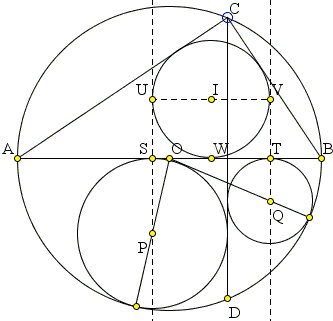Arithmetic Mean Sangaku: What Is This About?
A Mathematical Droodle
| What if applet does not run? |
Sangaku
- Sangaku: Reflections on the Phenomenon
- Critique of My View and a Response
- 1 + 27 = 12 + 16 Sangaku
- 3-4-5 Triangle by a Kid
- 7 = 2 + 5 Sangaku
- A 49th Degree Challenge
- A Geometric Mean Sangaku
- A Hard but Important Sangaku
- A Restored Sangaku Problem
- A Sangaku: Two Unrelated Circles
- A Sangaku by a Teen
- A Sangaku Follow-Up on an Archimedes' Lemma
- A Sangaku with an Egyptian Attachment
- A Sangaku with Many Circles and Some
- A Sushi Morsel
- An Old Japanese Theorem
- Archimedes Twins in the Edo Period
- Arithmetic Mean Sangaku
- Bottema Shatters Japan's Seclusion
- Chain of Circles on a Chord
- Circles and Semicircles in Rectangle
- Circles in a Circular Segment
- Circles Lined on the Legs of a Right Triangle
- Equal Incircles Theorem
- Equilateral Triangle, Straight Line and Tangent Circles
- Equilateral Triangles and Incircles in a Square
- Five Incircles in a Square
- Four Hinged Squares
- Four Incircles in Equilateral Triangle
- Gion Shrine Problem
- Harmonic Mean Sangaku
- Heron's Problem
- In the Wasan Spirit
- Incenters in Cyclic Quadrilateral
- Japanese Art and Mathematics
- Malfatti's Problem
- Maximal Properties of the Pythagorean Relation
- Neuberg Sangaku
- Out of Pentagon Sangaku
- Peacock Tail Sangaku
- Pentagon Proportions Sangaku
- Proportions in Square
- Pythagoras and Vecten Break Japan's Isolation
- Radius of a Circle by Paper Folding
- Review of Sacred Mathematics
- Sangaku à la V. Thebault
- Sangaku and The Egyptian Triangle
- Sangaku in a Square
- Sangaku Iterations, Is it Wasan?
- Sangaku with 8 Circles
- Sangaku with Angle between a Tangent and a Chord
- Sangaku with Quadratic Optimization
- Sangaku with Three Mixtilinear Circles
- Sangaku with Versines
- Sangakus with a Mixtilinear Circle
- Sequences of Touching Circles
- Square and Circle in a Gothic Cupola
- Steiner's Sangaku
- Tangent Circles and an Isosceles Triangle
- The Squinting Eyes Theorem
- Three Incircles In a Right Triangle
- Three Squares and Two Ellipses
- Three Tangent Circles Sangaku
- Triangles, Squares and Areas from Temple Geometry
- Two Arbelos, Two Chains
- Two Circles in an Angle
- Two Sangaku with Equal Incircles
- Another Sangaku in Square
- Sangaku via Peru
- FJG Capitan's Sangaku
|Activities| |Contact| |Front page| |Contents| |Geometry|
Copyright © 1996-2018 Alexander Bogomolny
The applet is hopefully suggestive of the following sangaku [Bicycle, #39]:
|
Points C and D lie on a circle with diameter AB, |
| What if applet does not run? |
We apply the Pythagorean theorem twice to the right triangles with hypotenuses joining the centers of the circles, as shown:

|
Let the distance from center O of the circumcircle to CD be d, the other centers I, P, Q, and the radii of the circles be R, r, rL, rR. Then the Pythagorean theorem gives
|
(r + d)2 + r2 = (R - r)2, for r = rR and (r - d)2 + r2 = (R - r)2, for r = rL, |
From which we express rR and rL:
| (1) |
rR = -(R + d) + √2R(R + d) and rL = -(R - d) + √2R(R - d). |
which shows that the arithmetic mean of the two equals
| (2) | (rR + rL)/2 = -R + (√2R(R + d) + √2R(R - d) )/2. |
One the other hand, we need to find the inradius r of the right ΔABC. For any right triangle with sides a, b and hypotenuse c, the inradius r can be found from
| r = (a + b - c)/2. |
In our case, c = 2R, while a and b can again be found with the help of the Pythagorean theorem. It's not hard to see that one of them is √2R(R + d) whereas the other is √2R(R - d), which conforms with (2) and shows that the horizontal distance between P and Q is 2r. We may rewrite (1) as
| (1') |
rR = -(R + d) + b rL = -(R - d) + a. |

|
Thus ST = 2r, where S and T are the points of tangency of (P) and (Q) with AB. In particular,
| (3) | r = (rR + rL)/2 = -R + (a + b)/2. |
What remains to show is that the midpoint of ST is exactly the point of tangency W of the incircle (I) with AB, i.e.
Let's compute
|
And we are done.
(This sangaku has a nice generalization.)
References
- H. Fukagawa, D. Pedoe, Japanese Temple Geometry Problems, The Charles Babbage Research Center, Winnipeg, 1989
Write to:
Charles Babbage Research Center
P.O. Box 272, St. Norbert Postal Station
Winnipeg, MB
Canada R3V 1L6 - J. Konhauser, D. Velleman, S. Wagon, Which Way Did the Bicycle Go?, MAA, 1996
|Activities| |Contact| |Front page| |Contents| |Geometry|
Copyright © 1996-2018 Alexander Bogomolny
73344887
